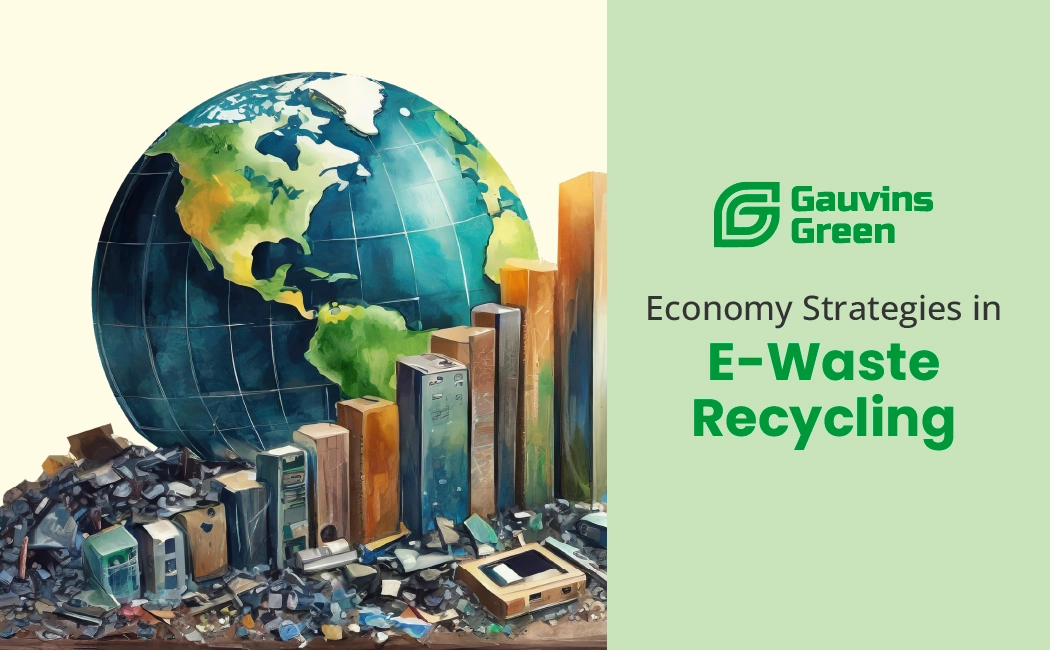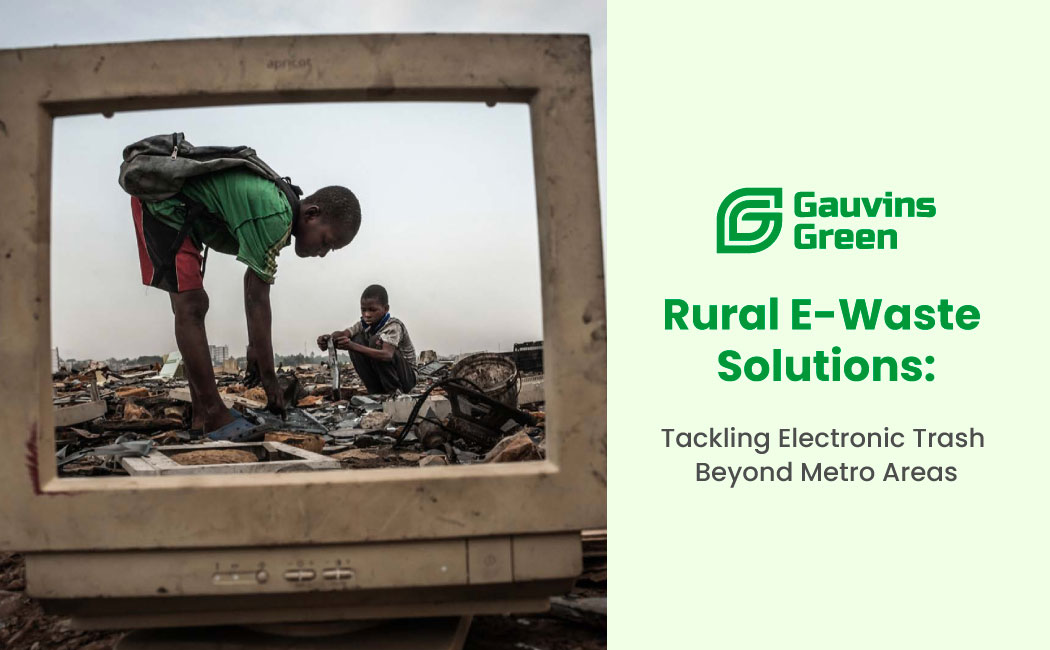|
Getting your Trinity Audio player ready...
|
In an age where technology evolves rapidly, electronic waste (e-waste) has become a pressing environmental concern. However, amidst this challenge lies an opportunity for sustainable innovation through the circular economy. This blog explores the transformative potential of circular economy strategies in e-waste recycling, focusing on the pioneering efforts of Gauvins Green. We’ll delve into the benefits, challenges, and real-world applications of circular economy principles in e-waste management, shedding light on Gauvins Green’s role as a trailblazer in this field.
Table of Contents
ToggleCircular Economy and E-Waste Recycling
The circular economy represents a paradigm shift from the traditional linear model of “take, make, dispose” to a regenerative approach that prioritizes resource efficiency and waste reduction. When applied to e-waste recycling, circular economy principles offer significant environmental and economic advantages. In India, where e-waste management is a pressing issue due to rapid technological advancement and increasing consumption of electronic devices, adopting circular economy strategies is paramount. By keeping materials in use for as long as possible through reuse, remanufacturing, and recycling, the circular economy minimizes the extraction of finite resources and reduces environmental degradation associated with e-waste disposal.
Case Studies: How Circular Economy Works in E-Waste
Let’s delve into some real-life examples of circular economy strategies in action within the realm of e-waste recycling. Gauvins Green, a leading player in the field, has implemented various initiatives to promote circularity and sustainability. One notable project involved the establishment of a closed-loop system for electronic components. Instead of discarding end-of-life electronics, Gauvins Green collaborated with manufacturers to reclaim and refurbish components for reuse in new products, thereby extending their lifespan and reducing waste.
Additionally, Gauvins Green partnered with local communities to set up e-waste collection centers, enabling residents to dispose of their electronic devices responsibly. These initiatives not only diverted e-waste from landfills but also created job opportunities and raised awareness about the importance of recycling.
Despite the successes, Gauvins Green also encountered challenges along the way. Logistics and transportation issues, as well as regulatory compliance complexities, posed significant hurdles to the implementation of circular economy strategies. However, through perseverance and innovation, Gauvins Green overcome these obstacles and continued to advance the circularity agenda in e-waste recycling.
The Economic Benefits in E-Waste Recycling:
Circular economy strategies not only benefit the environment but also yield significant economic advantages. Gauvins Green’s embrace of circularity has led to cost savings, increased efficiency, and the creation of new revenue streams. By optimizing resource utilization and reducing waste generation, Gauvins Green has lowered production costs and improved profitability. Furthermore, the refurbishment and resale of electronic products have opened up new market opportunities, generating additional revenue for the company. Overall, Gauvins Green’s circular economy initiatives have not only enhanced its financial performance but also positioned it as a leader in sustainable e-waste management.
Policy and Regulatory Frameworks for Circular Economy Strategies in E-Waste Recycling:
While circular economy strategies hold immense promise for e-waste recycling, their implementation is contingent upon supportive policy frameworks and regulatory environments. In India, the government has taken steps to address e-waste management through legislation such as the E-Waste Management Rules, 2016. These rules mandate the proper collection, segregation, and recycling of e-waste and impose responsibilities on producers, consumers, and recyclers to ensure compliance.
However, challenges remain in effectively enforcing these regulations and incentivizing circular economy practices. Gauvins Green has navigated these regulatory complexities by collaborating with policymakers and advocating for policies that promote circularity and sustainability. By engaging in dialogue with regulatory authorities, Gauvins Green seeks to influence policy development and create an enabling environment for circular economy initiatives.
Looking to the Future of E-Waste Recycling
As we look to the future, Gauvins Green remains committed to advancing the circular economy agenda in e-waste recycling. By continuing to innovate, collaborate, and advocate for change, Gauvins Green strives to create a more sustainable and resilient e-waste management solution system for generations to come.
FAQs
What is e-waste recycling, and why is it important?
E-waste recycling involves safely disposing of old electronics to prevent harm to the environment. It’s vital because electronics contain harmful materials like lead and mercury that can pollute if not handled properly. Recycling e-waste reduces pollution, saves resources, and cuts down on the need for new materials.
How does the circular economy approach differ from traditional e-waste management practices?
Traditional methods often end in landfills or incinerators, wasting valuable resources. The circular economy aims to keep resources in use longer by reusing, repairing, and recycling them. It’s about minimizing waste and making the most of what we have.
What are some common challenges associated with implementing circular economy strategies in e-waste recycling?
Challenges include logistics, technology limitations, and meeting regulations. Changing attitudes towards recycling can also be tough.
How can individuals and businesses contribute to circularity in e-waste management?
Individuals can recycle old electronics responsibly, donate or sell usable ones, and use energy-efficient devices. Businesses can offer recycling programs, design products for easy recycling, and buy sustainable electronics.
What role do government policies and regulations play in promoting circular economy practices in e-waste recycling?
They set rules for e-waste handling and encourage businesses to take responsibility for their products. Policies can fund recycling efforts and ensure everyone follows environmental rules.
How does Gauvins Green ensure data security and confidentiality during the e-waste recycling process?
Gauvins Green destroys data securely and follows strict protocols to protect personal information during recycling.
Can e-waste recycling be profitable for businesses, and if so, how?
Yes, businesses can make money by selling recovered materials and refurbished electronics. Recycling also saves on buying new materials and reduces waste costs.
What are some innovative technologies and approaches being used in e-waste recycling today?
New methods include robots for disassembly, smart sorting with AI, and chemical processes for valuable metal recovery. Circular economy ideas focus on designing products for easy recycling and teamwork between companies.
How can consumers responsibly dispose of their old electronic devices?
Consumers should use certified recycling programs, donate working devices, or trade them in for discounts. Remember to remove personal data and batteries for safety.




